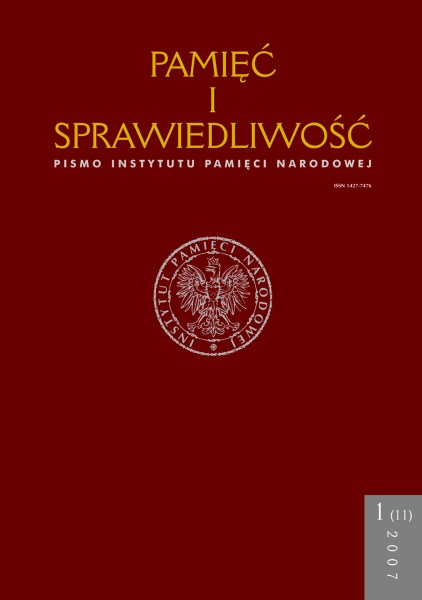Stalinowska wojna partyzancka na Ukrainie 1941–1944, część 2
Pamięć i Sprawiedliwość, V. 11 N. 1 (2007), pages: 119-143
Publication date: 2007-12-30
Abstract
The article describes Soviet partisan movement in Ukraine during WW2, its main periods and directions of activity, organisation and leadership of partisans, manning, distinguishing features of communist partisans in comparison with Ukrainian insurgents (UPA) and AK (Polish Home Army). The stress was put on little known aspects of partisan movement: relationships with civilians, terror, robberies, marauding, scorched earth strategy, postscripts to diversion and military operations, struggle of Soviet partisans and AK against Ukrainian nationalistic partisans.
The article concentrates on conditions and causes of crushing defeat of partisan movement in the fi rst year of the war (1941/1942), a turning point in the second year (1942/1943) and impressive success of the third year of the war (1943/1944)
reached in the environment of hostile west-Ukrainian citizens.
The summary depicts structure, system distinguishing features of Stalin partisan movement in the Ukraine: its reckless, thus quite effective diversion and military activities, neglecting lives of partisans by their leadership, terror towards civilians ethnically similar to partisans, conscious provoking occupants’ terror
against civilians and lack of desire to defend them, long-term activity in conditions of hostile or neutral civilians, badly organised and thought over system of requisitions of food and other material values from civilians, high level of marauding and robberies, low morals of troops (drinking, sexual violence, low discipline),
numerous inner confl icts.
Such distinctions can be explained by a simple fact that Soviet partisan movement was one of manifestations of belligerent stalinism.
Puoi leggere altri articoli dello stesso autore/i
- Aleksander Gogun, Władimir Ginda, [Recenzje] Przez pryzmat dokumentów najeźdźcy. Wendy Lower, Nazi Empire Building and the Holocaust in Ukraine, University of North Carolina Press, The United States Holocaust Memorial Museum, Chapel Hill 2005, 307 ss. , Pamięć i Sprawiedliwość: V. 19 N. 1 (2012)
- Aleksander Gogun, Jörg Baberowski, [Recenzja] Jörg Baberowski, Czerwonij teror. Istorija stalinizmu, tłum. z niem. na ukr., Kyjiw 2007 , Pamięć i Sprawiedliwość: V. 15 N. 1 (2010)
- Bogdan Musiał, Aleksander Gogun, [Recenzja] Bogdan Musial, Kampfplatz Deutschland. Stalins Kriegspläne gegen den Westen, Propyläen, Berlin 2008, ss. 584 , Pamięć i Sprawiedliwość: V. 14 N. 1 (2009)
- Aleksander Gogun, [Recenzje] Grabie˝ z kaukasko-rosyjskim rozmachem, 1944–1953 (Bogdan Musial, Stalins Beutezug. Die Plünderung Deutschlands und der Aufstieg der Sowjetunion zur Weltmacht, Propyläen Verlag, Berlin 2010, 507 s.) , Pamięć i Sprawiedliwość: V. 18 N. 2 (2011)
- Aleksander Gogun, Stalinowska wojna partyzancka na Ukrainie 1941–1944, część 1 , Pamięć i Sprawiedliwość: V. 10 N. 2 (2006)
- Aleksander Gogun, Franziska Bruder, [Recenzja] Franziska Bruder, „Den ukrainischen Staat erkämpfen oder sterben!“. Die Organisation Ukrainischer Nationalisten (OUN) 1929–1948, Berlin 2007 , Pamięć i Sprawiedliwość: V. 16 N. 2 (2010)
 Język Polski
Język Polski
 English
English
 Deutsch
Deutsch
 Français (France)
Français (France)
 Italiano
Italiano
 Русский
Русский


 PDF (Język Polski)
PDF (Język Polski)
